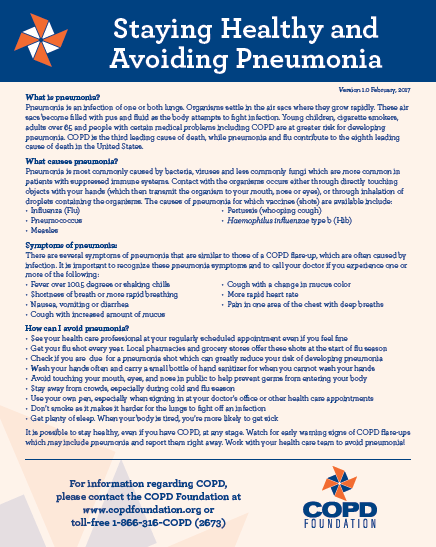Resource of the Month: Updated Pneumonia Fact Sheet
Posted on February 09, 2017 |
This post was authored by Kristen Willard, MS, Vice President of Population Health & Care Delivery at the COPD Foundation.
Pneumonia is a critical health concern for people with COPD. The incidence of pneumonia has been shown to be six to eight times higher in older adults with COPD as compared to their cohorts without pulmonary disease. People with COPD who develop these lung infections are also more likely to bear significant negative health outcomes related to their pneumonia. Along with influenza, it is the eighth leading cause of death in the United States.
In order to raise awareness about pneumonia and the ways people with COPD can decrease their chances of infection, the COPD Foundation has developed an educational one-pager.

The document describes what pneumonia is, what causes this type of infection, and what steps those with COPD can take to avoid developing it.
This new one-page document, titled “Staying Healthy and Avoiding Pneumonia” is the latest addition to the Foundation’s Fact Sheet series and is modeled after the Staying Healthy and Avoiding Exacerbations Fact Sheets. Healthcare providers can print this new material from our Educational Materials download library and distribute to their COPD patients (note that it is not available as a printed product in the online catalog, but is available for free in the COPDF library and perfect for local printing). The fact sheet is suitable for clinic drop boxes during flu and pneumonia season.
A few pneumonia facts:
Pneumonia is most commonly caused by bacteria.
Pneumonia can also be caused by a virus, or in people with suppressed immune systems can be caused by fungi.
Pneumonia can be passed by one person to another by touching the same object with your hands, then putting your hands to your eyes, nose, or mouth.
Pneumonia can be passed from one person to another by inhaling droplets that contain the organisms.
While flu and pneumonia may strike at any time of year, they are most prevalent from September to March.
Pneumonia is one of the top causes of hospital readmissions.
Pneumonia is extremely costly to the U.S. healthcare system; expenses total in the billions of dollars annually (according to the CDC, more than $10 billion in 2011).
In addition to a flu shot, pneumonia shots can help. Pneumonia shots are effective for years, but doctors have varied opinions on how many years this is.
Pneumonia can be prevented.
Download the Staying Healthy and Avoiding Pneumonia Fact Sheet here.
This page was reviewed on March 3, 2020 by the COPD Foundation Content Review and Evaluation Committee